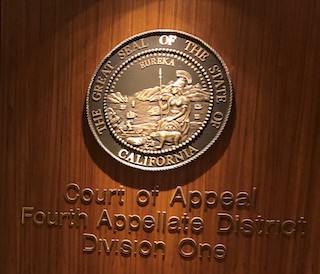In September 2018, Misty Lynn Probert entered a Kohl’s department store in San Diego County. A loss prevention officer in the store noticed Probert acting like she was about to commit shoplifting, so he watched her closely.
As the loss prevention officer suspected, Probert then walked to the junior’s department, quickly grabbed five pairs of jeans without looking at their prices, enter into a dressing room and emerge a few minutes later holding only her purse and one pair of jeans. The loss prevention officer checked the fitting room and found no jeans left behind.
Probert then went to the junior girls department and picked up a decorative bow, which she clipped onto her own jacket and continued walking. She then picked up a pair of pink shorts, which she directly placed right into her purse.
As soon as she walked out of the store without paying for any items, three plain clothes loss prevention officers immediately stopped her. One allegedly told her he worked for Kohl’s and showed her his loss prevention badge. He then asked her to come back inside the store. Probert ignored the officers and kept walking.
At that moment, Alfred Lopez-Vinck pulled up and stopped his car in front of the store just a few feet from Probert. Lopez-Vinck got out of the car and was holding a three-inch blade knife at chest or head high level in a “very aggressive manner” (according to the loss prevention officers) and told the loss prevention officers to “back the fuck up.” He walked toward the officers and, in response, the officers took a few steps back. Meanwhile, Probert opened the car door and got into the car.
The loss prevention officers estimated Lopez-Vinck was six to fifteen feet away. He then got into the car and left with Probert.
 Fourth Appellate District Court of Appeals Div 1 San Diego
Fourth Appellate District Court of Appeals Div 1 San Diego
The two were later arrested and the San Diego District Attorney’s office charged both Probert and Lopez-Vinck with three counts of robbery (Penal Code § 211). They also charged Lopez-Vinck with three counts of assault with a deadly weapon (Penal Code § 245(a)(1))). The information also alleged that Lopez-Vinck had suffered two prior felonies (Penal Code § 1203(e)(4)) and one prison prior (Penal Code § 667.5(b)). It was also alleged that Lopez-Vinck personally used a deadly and dangerous weapon, a knife, in the commission of the offenses.
At trial, Lopez-Vinck argued that he thought Probert was being mugged, so he was acting in her defense and moreover, he was too far away from the loss prevention officers to engage in any act that was likely to cause injury and due to his distance, he did not have the ability to injure anyone.
Lopez-Vinck also argued that the jury should have been instructed on the charge of brandishing a weapon (Penal Code § 417) as a lesser-included charge of assault with a deadly weapon.
After a joint trial, a jury found Lopez-Vinck guilty of all counts and all enhancements. The judge sentenced him to three years in state prison.
Lopez-Vinck then appealed his conviction to the Fourth Appellate District Court in San Diego.
The Fourth Appellate District began its analysis of Lopez-Vinck’s assault argument by reciting what Penal Code § 240 defines as assault: “An assault is an unlawful attempt, coupled with a present ability to commit a violent injury on the person of another.”
The appellate court quickly confirmed that Lopez-Vinck did commit an assault, as the evidence was that he exited his vehicle holding an exposed three-inch blade knife, raised it to shoulder or head high, stood with a “fighting stance” and yelled toward the loss prevention officers “back the fuck up.”
As to his argument that the assault with a deadly weapon (ADW) charge must be reversed and modified to the misdemeanor offense of brandishing a deadly weapon because the conduct constituting ADW is prohibited under the more “specific” offense of brandishing a weapon, which carries a less severe penalty and therefore controls, the appellate court noted his argument is “premised on a doctrine often referred to as the Williamson rule.” In re Williamson (1954) 43 Cal.2d 651, 654.
“Under the Williamson rule, if a general statute includes the same conduct as a special statute, the court infers that the Legislature intended that conduct to be prosecuted exclusively under the specific statute. In effect, the special statute is interpreted as creating an exception to the general statute for conduct that would otherwise be prosecuted under either statute.” People v. Murphy (2011) 52 Cal. 4th 81, 86.
The Williamson preemption rule is applicable (1) when each element of the general statute corresponds to an element on the face of the special statute, or (2) when it appears from the statutory context that a violation of the special statute will necessarily or commonly result in a violation of the general statute.” People v. Watson (1981) 30 Cal.3d 290, 295-296.
Turning then to a comparison of ADW with brandishing a weapon, the court found that “the elements of these two offenses do not correspond.” People v. Escarcega (1974) 43 Cal. App. 3d 391, 398; see also People v. Torres (1957) 151 Cal. App. 2d 542, 544-545 (“An assault with a deadly weapon can be committed without violating any provision of Penal Code § 417, such as firing a gun through a coat pocket without either drawing or exhibiting the weapon and without then being engaged in a fight or quarrel.”)
The citation for the Fourth Appellate District Court ruling discussed above is People v. Alfred Lopez-Vinck (4th App. Dist., 2021) 68 Cal. App. 5th 945, 283 Cal. Rptr. 3d 922.
For more information about brandishing a weapon and issues based on defendant being a distance away from the victim, please click on the following articles:
 Fourth Appellate District Court of Appeals Div 1 San Diego
Fourth Appellate District Court of Appeals Div 1 San Diego